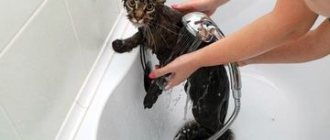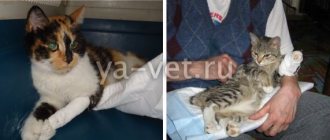The soft, velvety fur of a domestic cat is sometimes exciting to touch. Stroking a cat is a surprisingly pleasant and useful activity for both the owner and the animal. Every living creature enjoys being shown care and attention. However, it would be useful for a person to know how to stroke a cat correctly and when, so that it brings pleasure to both.
Why pet a cat?
Benefit to people
The presence of a four-legged furry in the house itself brings comfort and warmth. When a person returns home, he wants to leave the fuss, troubles, and irritating factors behind the threshold. After petting the cat, he feels a surge of positive emotions, relaxes, calms down, smoothly moving into the comfort zone. Accordingly, this has a positive effect on health - an accelerated pulse returns to normal, relaxation of muscles and vessel walls reduces high blood pressure, and stress goes away. As a result, sleep normalizes. The cat intuitively senses the owner’s mood and “understands” his state.
If a cat lay near a person’s sore spot and purred, the illness may go away.
What benefits does stroking give to four-legged animals?
For cats, such actions are an important part of the relationship. Despite their independent and proud disposition, they love affection, tenderness and attention. When a cat is caressed, the movements remind her of the sensation of being licked by her mother's tongue. From such manipulations, the animal seems to enter a state of light trance, remembering its childhood. In addition, the animal perceives stroking as a massage.
Interpretation in different dream books
In dream books from famous personalities, stroking a cat has the following meanings:
- Miller. Stroking a dirty and unkempt animal means serious troubles that will change the dreamer’s life for the worse. If in a dream you petted a purebred and fluffy cat, minor problems await you in the near future, which you can easily cope with on your own. For single people, such a dream symbolizes unrequited feelings or betrayal in a future relationship.
- Vanga. According to Vanga’s interpretation, stroking a cat most often means a deterioration in relationships with a loved one or problems at work. To avoid bankruptcy, it is recommended to take a closer look at your colleagues and manage your projects yourself. You should have a sincere conversation with your significant other - this will help identify existing problems and maintain harmony.
- Freud. Stroking a furry pet, according to a famous psychologist, symbolizes the desire for intimacy on a subconscious level. Also, such a night vision can warn of betrayal of a loved one, strong jealousy or a short love affair that will leave the dreamer with negative emotions.
- Nostradamus. In the dream book of Michel Nostradamus, stroking a cat means ingratitude or betrayal of one of the family members. If in a dream you caressed many little kittens that purr with pleasure, an influential person will appear in real life, and he will become a support in all your endeavors.
- Meneghetti. Monotonously stroking a pet means there is an energy vampire in your immediate environment. The presence of this person provokes a deterioration in the psychological and physiological state of the dreamer, so it is recommended to identify this person as soon as possible.
- Hasse. The medium warns that petting a cat in a dream is a sign of excessive gullibility in real life. To achieve success in future projects, you need to learn to understand your colleagues and not let employees know your ideas. If the animal looks sick, you need to pay more attention to your family, as they are in dire need of your support.
- Medea. A dream in which you stroke a cat warns of the onset of a black streak. In the near future, all the dreamer’s actions will be negatively perceived by people around him, so it is recommended to refuse drastic changes in work or personal life. The sorceress recommends taking a short vacation and spending it alone with yourself.
Each person has a different attitude towards cats and cats, but the appearance of the image of this animal in a dream often warns of possible troubles or drastic life changes. To avoid negative consequences, it is recommended to listen carefully to the sensations caused by the dream and try to avoid rash actions.
When can you pet a cat?
An observant owner, knowing the temperament of his pet, sees when he wants affection and when it is better not to touch him.
At times the animal rubs against objects, taps its tail or purrs.
This does not necessarily indicate that the kitten wants to be petted. In this way, the pet can show interest, greeting or irritation. An attentive owner, observing behavior, will know exactly when the animal is in a happy state and is ready to be petted. The main thing to remember is that this cute creature is not a plush toy, but a whole separate world with its own life cycle and desires.
How to iron correctly?
Conventionally, the owner’s behavior can be divided into the following stages:
- Before active actions, you need to warn the cat about your intentions by bringing your palm closer to its muzzle and allowing it to sniff.
- If the fluffy reacts calmly and rubs against your hand, then he is ready to continue.
- It is better to start gently stroking behind the ears, scratching the neck and chin. Gradually move from the head to the back.
- Each individual has favorite places for ironing, which the cat shows with all its appearance and asks for. Having identified these zones, there is no need to skimp on affection and tenderness.
- If a four-legged animal turns away, moves away, and begins to scratch, we must respect its “opinion” and freedom, and not cause more aggression. There is no need to touch a sleeping cat.
- Do not forcefully stroke an angry kitten with your hands, otherwise it will try to bite or scratch.
How to write a story about a cat in English
Before turning to the example, let's look at a couple of questions from the theoretical part. A story about a pet in English is often assigned to schoolchildren as homework. This is where the kids have a lot of questions: what to write about, how to start an essay, and what words would generally be appropriate in a story about a pet. Therefore, we will begin the material by providing useful recommendations and a list of vocabulary, and then we will show examples of composing a story.
Tips for text content
So, what could the essay be about? Yes, in fact, it’s very easy to write a story about a cat in English. Here are a few mini-topics to cover as an example:
- Description of the cat’s characteristics (appearance, character, age);
- List your pet's favorite food;
- A story about the cat's favorite activities;
- An interesting case from life;
- A story about your love for a pet.
Considering that the story about a cat in English with a translation for grade 3 or 4 has only a dozen sentences, the listed points for composing the text are more than enough for you. The only question is what words to choose for the story. Let's talk about this now.
Required vocabulary
So, to write a story about your own furry pet, you will need a certain vocabulary. And, if you are not confident in your abilities, then the following selection will help you overcome the difficulties that have arisen and start writing the text. In addition to translation, we will provide words with transcription so that you can easily read your story out loud or even make an oral retelling.
| Vocabulary on the topic “My cat” (My pet) | ||
| Word | Transcription | Translation |
| cat | [kæt] | Cat Cat |
| kitten | [ˈkɪtn] | kitty |
| pet | [pɛt] | a pet |
| beloved | [bɪˈlʌvɪd] | Darling |
| adorable | [əˈdɔːrəbl] | adored |
| cute | [kjuːt] | Cute |
| cat's name | [kæts neɪm] | cat name, cat nickname |
| is...years old | [ɪz... [jɪəz əʊld] | he (she) is ... years old |
| fluffy | [ˈflʌfi] | fluffy |
| white | [waɪt] | white |
| black | [blæk] | black |
| ginger | [ˈʤɪnʤə] | ginger |
| gray | [greɪ] | grey |
| fur | [fɜː] | wool |
| body | [ˈbɒdi] | body |
| belly | [ˈbɛli] | tummy |
| tail | [teɪl] | tail |
| back | [bæk] | back |
| muzzle | [ˈmʌzl] | muzzle |
| eyes | [aɪz] | ears |
| whiskers | [ˈwɪskəz] | mustache |
| chest | [ʧɛst] | breast |
| legs | [lɛgz] | legs |
| paws | [pɔːz] | paws, pads |
| ears | [ɪəz] | ears |
| nose | [nəʊz] | nose |
| mew | [mjuː] | mew |
| purr | [pɜː] | purr |
| scratch | [skræʧ] | to scratch |
| cuddle | [ˈkʌdl] | hug, cuddle |
| to pet | [tuː pɛt] | stroke, caress |
| play | [pleɪ] | play |
| cat toys | [kæt tɔɪz] | cat toys |
| hunting | [ˈhʌntɪŋ] | hunting |
| lay | [leɪ] | lie |
| sleep | [sliːp] | sleep |
| funny | [ˈfʌni] | funny |
| smart | [smɑːt] | smart |
| nice | [naɪs] | cool, wonderful |
| favorite place | [ˈfeɪvərɪt pleɪs] | favorite place |
| eat | [iːt] | eat |
| fish | [fɪʃ] | fish |
| milk | [mɪlk] | milk |
| sausages | [ˈsɒsɪʤɪz] | sausages |
| meat | [miːt] | meat |
| sour cream | [ˈsaʊə kriːm] | sour cream |
| love | [lʌv] | be in love |
| take care | [teɪk keə] | take care |
Well, with such a vocabulary, you can definitely easily compose a story about a cat in English with translation for grade 3. Moreover, there is enough vocabulary for essays for grades 5-7! And we will support this statement with a clear example, but first we need to add a note about English grammar.
Important grammatical nuance
According to the rules of English grammar, animals are usually denoted by the common pronoun it. It doesn’t matter what kind of animal it is or what gender it is.
- Find that mouse and get it out of the house!
Other English topics: English lexical task at elementary level
The pronouns he and she in English are intended to refer to people, but they are also used in relation to animals! What kind of loving owner would call his cute cat or devoted dog the pronoun it? Of course, depending on the gender of the animal, the English will say he or she about it. Therefore, a story about your cat in English should contain exactly these pronouns.
- My cat is so funny. She likes to play with cat toys. — My cat is so funny. She loves to play with cat toys.
Also, the pronouns he and she in relation to animals are used in fairy tales, cartoons, children's games and plays. In the story, the animal is endowed with human qualities: feelings, intelligence, cunning, curiosity, kindness, etc. Therefore, in such cases, the use of he and she is considered appropriate.
- Once upon a time, there lived a white goat. She was very old and wise. — Once upon a time there was a little white goat. She was very old and wise.
Otherwise, when we are talking simply about an animal, without expressing emotions and feelings, it is more correct to use the pronoun it. It is usually used to refer to wild animals, livestock, stray dogs, etc.
So, when describing an animal in English for a story, feel free to use the pronoun he or she. But at the same time, do not forget that with a neutral attitude in English it is customary to designate animals with the pronoun it.
Other topics that may be of interest:
- A story about your favorite toy in English
- Tell us about yourself in English
- Story about a friend in English
- A story about a famous person in English
- Story about a family in English
- A story about “My favorite sport”
- Topics “My favorite food” in English
- Essay “My Birthday” in English
Pleasant areas for stroking
Head and back of the head
The favorite place to touch is the head, in particular, if you scratch behind the ear, you can hear a purr.
Almost all cats love affectionate touches on the head. Kittens remember that this is where their mother licked them. These pleasant sensations remain in the subconscious for life. Sitting comfortably on your hands or knees, the cutie will gratefully accept the love of his owners if he is scratched behind the ears and the back of his head. The cheeks are especially sensitive - the area behind the mustache below the eyes. By lightly patting this area, you can hear purring.
Breast and neck
With gentle movements of your fingers, moving from the chin to the neck, you can observe how the cat is pleased, and he stretches his neck forward, submitting his palms and squinting his eyes. These areas are located in such a way that it is difficult for a cat to comb them out on his own, so help is simply necessary here. He will not refuse several repetitions of the slow combing procedure, hinting at continuation.
Back and sides
Wide, gentle movements of the palm from the head to the base of the tail along the spine will demonstrate care. After all, such a massage relieves muscle spasms and stress on the back. Arching the body and rubbing the forehead on the hand encourages the owner to repeat what the cat liked. The paws remain controversial areas. Here the reaction may be different. It must be carefully clarified and conclusions drawn.
The cats called. (it’s impossible to read without a smile))
I accidentally came across these sweet stories on the Internet. I read it to my friends at breakfast today: everyone was smiling). We don’t have cats, but we would love to have such “smart ones”))).
The author of the text is Yulia Rubleva.
**********
The cats called. - Where are you? - Barsik asked. “Where is this?” I said. “I arrived yesterday, you saw, now I’m wandering around the city, then...” “We looked at your Facebook,” said Barsik. - How did you look? - I said. “Do cats know how to…” “They know how,” said Barsik. Martin snorted into the phone next to him. I fell silent heavily. “You post other cats there,” said Barsik. - Not us. “And he likes the dachshund,” added Martyn. — He’s reading about dachshunds. Poetic. About the dog, that is. “About the dog,” Barsik said weightily. - Where are you from anyway... Where is all this “you post, likes” - where? - I said. “We have a Facebook for cats,” said Barsik, “we follow you from there.” We designated you there as “close to the cat.” - You post there... How is it... My photos suddenly... Suddenly? - I said. - Wait! I do not understand. “We don’t post how you sit on the tray, for example,” said Barsik. “We also don’t post how you lie around in the morning.” “Sometimes we post how you eat,” Martyn added and began to sniffle again. - Your bowl and ours next to it. Like compare, good cats. Five hundred likes. Hundreds of people who want to help write in PM. - Are they judging me? — I asked obediently. “Yes,” said Barsik. We fell silent. “We joined the Unironed Cats group,” said Martyn. “Eight countries, ninety thousand participants,” said Barsik. - The plague of our time. “There was a photo of a mechanical smoother recently,” said Martyn. — While the owners are away. Iron, black, scary. What can you do? If you're flying back and forth all the time. “Recently,” said Barsik, “one post there received a hundred thousand likes.” - Which? - I asked. “One owner of one “Unironed Cat” brought him eight jars of agar-agar in a tie,” said Barsik. “Foie gras,” Martin corrected. “Wait,” I said. - Drive away. Foie gras is under sanctions. “Smuggling,” explained Barsik. “We’re talking about wearing a tie,” Martyn added. “That’s the kind of tie he should have,” I said. “Or he just loves his cats,” said Barsik. “Yes,” said Martin. “The size of the tie doesn’t matter if you love your cats,” said Barsik. “You can always bring a jar or two of agar-agar.” “Foie gras,” said Martin. - What do you want from me? - I said. “At least beef,” said Barsik. “A rabbit with rice is crap, with vegetables it’s crap, just a rabbit is crap,” Martyn jabbered. “Martyn, I heard,” I said. - Tell me, can’t you just ask? Do you really need to blackmail with these photos, “Unironed cats”, tie size? I spoiled you. “Martyn still needs a cat,” Barsik said heavily. “Let him contact the Unironed Cats community,” I said and laughed.
************
The cats called. They spoke in gloomy voices.
- When will you fly? - Barsik asked. “In a week,” I said. - What will you bring? - asked Barsik. “Let me fly away,” I said. “We are not ironed,” said Barsik. “Oh, well, don’t,” I said. “We are bloggers,” said Martyn. - Since when? - I asked. “Your subscribers read us,” said Martyn. “If I want, I won’t write about you anymore,” I said. “You’re not leaving just in a week,” said Barsik. “Your summer is outrageous,” said Martin. - AND? - I asked. “We want to manipulate you,” said Martyn. “Quiet, fool,” said Barsik. - No, what’s wrong? She flies here, flies here, she thinks she bought us canned food, stores it under the bench, and we will be so silent,” said Martyn. “We should be so timid,” said Barsik. “Like we were bought with this rabbit of hers,” said Martyn. “Beef,” said Barsik. “We are so kind of soulless,” said Martyn. “Like all we have to do is eat,” said Barsik. “Yes,” said Martin. - AND? - I said. “In the Unironed Cats community they write about love,” said Barsik. “About the closeness between owners and cats,” said Martyn. “About the blast furnace,” said Barsik. “Quiet, fool,” said Martin. -Where did you get this from? “I’ve been reading too much about the group “Ancient Grain Growers,” sorry,” said Barsik. “What a mess,” I said. - So what do you want? “You’re not just petting us,” said Barsik. “And with meaning,” said Martin. “Say something,” said Barsik. “They write “affectionate,” said Martyn. - Do you know how to be affectionate? “Say “I love you, my cats” and pet, and not just silently,” said Barsik. “Okay,” I said. - I will stroke you and talk to you. “Separately for me, separately for him,” said Martyn. “Yes, don’t go together,” said Barsik. - Smooth each one and speak to each one. “And so that no one else sees,” said Martyn. “In the Unironed Cats community, one owner ironed his cat to the point of baldness,” said Martyn. “Quiet, fool,” said Barsik. - Teach her
**************
“What, Martyn,” says Barsik, “maybe you’re a citizen?” “I’m a cat,” says Martin. - And what? - Ours is an abuser, that’s what. He deals with abuse,” says Barsik. - What? - Martin says with respect. “Abusive,” says Barsik. - It is delicious? - says Martin. “You’re a fool, even though you’re a cat,” says Barsik. - in “Unironed Cats” Kesha Myagky says that all our owners are abusers. “Let me explain in human terms,” says Martyn. - otherwise he himself tormented me for “worms” and “semanticism”, but what the hell. - Well, remember, on Facebook for cats everyone wrote that they would drink from the toilet, or, for example, eat some kind of thick liver, or canned food, go to lick themselves, and their owners would grab and grab across their full belly and let them kiss their mustache . Do you remember? - says Barsik. “I remember,” says Martin. “This is abuse,” says Barsik. — Is kissing on the mustache an abuse? - asks Martin. - Kiss the mustache when it’s sudden! - Barsik explains. “You didn’t plan it, but your butt will be grabbed and grabbed...” “I understand that,” Martin interrupts. “But you and I used to say that when someone kisses you right on the mustache, it’s passion.” That, they say, women have a passion for their cats, so they grab them. And this tenderness. Therefore, they don’t even care about a drunk toilet. “I don’t quite understand yet,” Barsik admits, “when it’s passion and when it’s abuse.” But abuse must be prohibited, and passion must be endured. Show respect for a woman's feelings. “Yes, in Unironed Kitties they also write about this, respect, they say, for the feelings of a woman, that is, a cat, is the key to a whole face,” Martyn thinks. “Ugh, I hate it when you sit there, like you’re not a straight man, but what a kitty,” Barsik winces. - Okay, listen. In short, let’s ban her abuse. “Come on,” says Martin. “We just need to develop a conceptual apparatus.” - What? - Barsik is amazed. - Where did you get this again? “Our political scientists are watching,” explains Martyn. — Before they have dinner, they say “conceptual apparatus,” “conceptual apparatus.” And then they have dinner. Sausage. “Okay,” says Barsik. “You’ll tell me everything later, what kind of pipe it is, and what kind of sausage it is.” “This is a device so that the sausage fits well inside,” says Martyn. - I understand. “Let’s get started,” Barsik announces. - What should we forbid her? “We’ll forbid you to say one word, you hate it,” says Martyn. “I can’t even pronounce it, it’s disgusting.” - Which? - says Barsik. “Kytya,” says Martyn. “I hate it,” says Barsik. - It’s already cringing. Kitya! “And me,” admits Martin. - He takes us, squeezes us just like that, and says - katya, katya! In such a nasty voice, as if we were morons. “Yeah,” says Barsik. - Not a kitty. Not a cat. Not even shoo! And kitya! ugh! I hate it! “I hate it,” Martin shudders. - Let's stop her! - We'll ban it! - says Barsik. - And let’s forbid kissing us on the stomach. - Why? - asks Martin. “I’m harsh,” says Barsik. - I am strong. I have claws. And the scruff. Let him respect! And she knocks me over, and you can clearly see that my belly is fluffy and defenseless, like a raccoon! I hate it! Ban her! “Forbid her,” Martin sighs. - And I like it when she scratches my tummy and says that I have fur there the color of baked milk... - Don’t get limp! - Barsik says sternly. - We are not raccoons with our bellies upside down! Abuse will not work! Are you still purring? “Sometimes,” Martin admits. - Quietly. “You must sternly show with your whole face that this is violence against a person!” - says Barsik. “Okay,” Martin sighs. - And what kind of abuse is that? - Hey! - says Barsik. “Don’t disgrace me, hillbilly, you come from a decent family.” But she has some kind of, ugh, abuse,” she sings. - Sings! exactly! - Martin recalls. “In such a creaky voice,” says Barsik. - About us. Two verses. “I like it about us,” Martin says shyly. - Maybe let him sing? “I didn’t ask her to sing about us!” - says Barsik. - Singing without asking is abuse! There are the words “hairy Barsik, hairy Martyn” - do you like it? “I like it,” Martin presses his ears. - Hairy. Gently. I'm not bald like an Abyssinian. I'm a hairy tabby! “We are fluffy,” explains Barsik. - Furry. Shaggy! And the hairy one may be some kind of humanoid! — Shall we ban? - Martin sighs. - We'll ban it! - says Barsik. - Let him change it into striped. I'm striped! Look for more striped ones like this! - And I'm striped! - Martin becomes dignified. - Hairy tabby! “You stupid thing,” says Barsik. - So with you it will be abuse after abuse. Okay, let's go. Develop the device. Sausage, liver. To lie down well. “Let’s go,” says Martin. - And we’ll write in “Kotiki” that we forbade her to “kitya” and sing. “And so that she doesn’t scratch her belly like a raccoon,” says Barsik, “and be careful not to purr, resist her abuse.” Resist. Don't fall apart like a snot. If he wants to scratch, let him scratch our beard or behind our ears. There is room to scratch! “I won’t,” Martin whispers. - I won’t purr. Abuse will not work.
Why can't you pet your tail?
This part of the body is responsible for several functions:
It is not recommended to touch the tail, as it contains nerve endings and touching it causes discomfort to the animal.
- coordinates movements;
- shows the emotional state of the moment;
- In some breeds it serves for additional heating.
It is not recommended to stroke the tail and its base. Touching causes irritation, nervous movements, and sometimes outright aggression or an attempt to claw at the animal. There are many nerve endings passing through here, and their activation brings considerable discomfort to the animal. The back can be stroked only to the base of the tail, without trying to touch it.
Where should you not touch a cat?
If the pet lies on its back, showing a soft belly, then it shows complete trust and openness. This is a very vulnerable area and is available for petting only after the invitation and permission of the cat. He doesn't like patting his belly and is more likely to lead to play with biting and scratching. Do not move in the direction opposite to hair growth, lifting the hair with force.
You should not stroke your cat against the grain, as this causes pain, especially in short-haired cats.
A defensive reaction occurs instinctively - the cat attacks, bites, scratches, and sometimes hisses. Any representative of the cat family would not want to feel discomfort from touching the delicate and sensitive ears. The ears help to choose the direction of movement. They are equipped with a rich nervous network. Even a light breeze causes the cat to shake its ears.
What can you get infected from a cat?
Cat lovers who try to hug an animal can get not only injured, but also more serious illnesses. Even if a pet has never gone outside, it can be a carrier of dangerous infections, contracting them through food or dirt.
If a person decides to take a stray animal into his home, then he is at great risk. Veterinarians strongly recommend that your street animal first undergo a full examination at the clinic to ensure that it is in excellent health, and only then begin closer communication with your furry friend.
- Sanatoriums of the Crimea of the Russian Ministry of Defense for military pensioners - a review of the best
- 6 best vitamins for the heart and blood vessels
- How to deal with overeating
There are several common diseases that can be contracted from cats.
Helminthiasis
Worms are common in animals. Almost all stray four-legged animals suffer from helminthiasis. Parasitic worms are also found in pets that do not go for walks at all.
Parasites are varied, many of them are invisible to the human eye, because they are microscopic in size. When an animal goes to the toilet, it buries its own feces with its paws, so infection, larvae and the parasites themselves can remain under its claws and on the skin. They can easily enter the human body.
Parasites can be divided into several types:
- flukes;
- round;
- tape
All of them have a destructive effect on the body, live in the intestines and other organs. If a cat is infected with helminthiasis, it will have certain symptoms:
- the animal constantly wants to eat, but does not gain weight;
- constipation and diarrhea are a constant problem for your pet;
- the cat often sleeps and is not active;
- vomit;
- the pet “rides” on the floor with its backside, trying to scratch.
If such symptoms are detected, it is important to exclude bodily contact with the four-legged animal and undergo an examination at a veterinary clinic as soon as possible. If helminths are detected, the cat and the whole family will have to be treated.
Fungal infections
You need to understand what hugging cats can lead to, because there is a danger of contracting fungal infections. They are often observed in kittens and adult cats. Furry companions can bring the following fungal infections to their owners:
- ringworm, which feels great on the human body, in the hair;
- candidiasis, which develops in the intestines, on the mucous membranes, and skin;
- Malassezia progresses in the ears;
- sporotrichosis settles deep in the skin;
- Blastomycosis is a dangerous infection that develops in the brain, bones, lungs, and other organs.
Ringworm is very common in furry pets. The infection begins to develop on the skin, and the cat's hair falls out. Ringworm is often found in children who adore animals. Fungal infections are treated with medications for internal and external use, which should only be prescribed by a doctor.
Bacterial infections
During the hugs of tailed comrades, bacterial infections occur. Diseases appear instantly, are severe, and are immediately noticeable. Every disease has a hidden stage, when it is difficult to notice changes in the body.
- Mortgage for disabled people - offers from Russian banks, preferential interest rates and lending conditions
- What problems do cashback cards have?
- Uzbek lagman recipe with photos
Types of infections in this category:
- Salmonellosis occurs in kittens and young animals up to one year old, because their immunity has not yet developed. Pets easily become infected through poor quality food. Manifestations of infection resemble symptoms of acute poisoning. The temperature rises, diarrhea and vomiting begin. If the disease becomes chronic, it penetrates the lungs.
- Staphylococcus - transmitted both through direct contact with an animal and by airborne droplets. Boils and purulent pimples appear on the surface of the skin, and abscesses occur in the internal organs. The temperature of both the pet and the person rises, and appetite disappears.
- Tuberculosis can be cutaneous, intestinal or pulmonary. The symptoms are similar: there is an increase in temperature, the condition of the body worsens. The pulmonary form provokes a cough; during an intestinal infection, problems with stool begin; during a skin infection, areas of the epidermis become inflamed.
- When hugging cats, you can even get tetanus, plague or other serious infections that are difficult to cure and can be fatal. Bacterial infections require treatment with antibiotics, which must be prescribed by a doctor.
Toxoplasmosis
The infection is common among furry four-legged animals. Intracellular parasites enter the body. Microorganisms first parasitize in the intestines, then gradually penetrate the internal organs. Chronic disease causes damage to the central nervous system.
The symptoms of the disease are similar to a cold. Coughing and sneezing, fever, increased temperature are observed, tears flow from the eyes, and upset bowel movements appear. The disease quickly becomes chronic, acute symptoms disappear. Strong immunity can prevent the development of the disease, but a person or animal will carry it throughout their life.
Rabies
The disease is dangerous! It is transmitted through cat saliva to humans. After a bite, infection can easily occur. The asymptomatic incubation period lasts three weeks. The first signs of infection are:
- change in behavior, the animal becomes fearful, shows excessive affection;
- heavy salivation;
- diarrhea and vomiting, problems with stool and gastrointestinal tract;
- paralysis, convulsions;
- fear of water, bright lighting.
Veterinarians have not yet been able to find a cure for this disease. Prevention is the absence of contact between your pet and street animals. If rabies is detected, the furry four-legged animal is euthanized to save the owners from danger. Rabies is rare and mainly affects stray animals. Infected cats exhibit inappropriate behavior, it is dangerous to hug them, and death is possible if infected.











